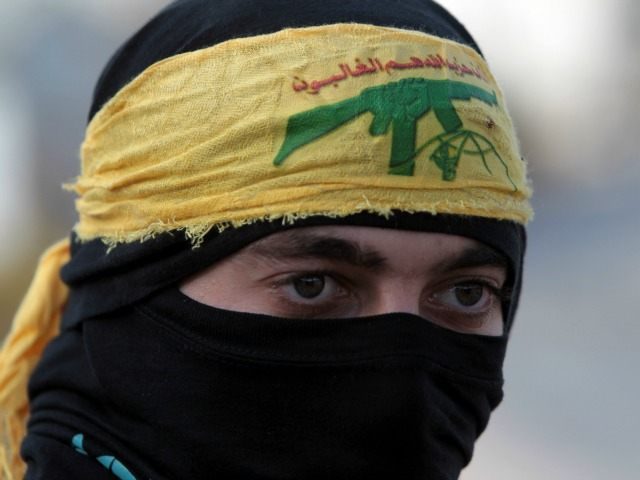U.S. military officials, human-rights activists, and sources within Syria’s fractious insurgency are painting a grim picture of growing Iranian influence, achieved in part by Iran’s proxy Hezbollah paying rebel commanders formerly supported by the United States to switch sides.
The situation is especially troubling because Iran’s power is spreading along the border with Israel.
The Wall Street Journal on Thursday published an extensive report on Iranian influence in Syria sourced to U.S. officials, including the envoy to Syria, the London-based Syrian Observatory for Human Rights, think-tank analysts, and a former rebel commander. The rebel commander estimated Hezbollah has recruited at least 2,000 fighters formerly opposed to the regime in Damascus, many of them from groups that were supported by the United States until funding was withdrawn last year.
The merits of continued funding for rebel groups became questionable as Russian and Iranian support helped dictator Bashar Assad turn the tide of the Syrian civil war, the ongoing refugee crisis damaged the stability of not just the Middle East but Europe, and it grew increasingly difficult to ignore the unsavory character of many rebel groups.
The unpleasant epilogue for the civil war envisioned in the Wall Street Journal piece emphasizes how difficult it was to find reliable “white hat” allies in Syria all along. It also stresses how dangerous it was to give the terror masters of Iran huge amounts of money with President Barack Obama’s nuclear deal, money that could be passed along to destabilizing Iranian proxies across the Middle East.
U.S. envoy to Syria Joel Rayburn on Friday called Hezbollah’s activities a “highly destabilizing prospect,” noting that Iran is not merely interested in wrapping up the Syrian civil war by turning the last few effective rebel militia forces against each other.
“The idea that Hezbollah would be expanding its presence down there on the Jordanian frontier, near the Golan Heights, near the Israeli frontier. This would increase the chance for conflict,” Rayburn warned.
The WSJ pointed out that Iran is doing a lot more than hiring a few mercenaries:
In a sign of further efforts to deepen its presence in the area, Iran in late October established a branch of a Shiite religious organization, al-Zahra, in the southern province of Daraa, following a visit to the area by a representative of Iran’s supreme leader, according to ETANA Syria, a civil society organization that monitors southern Syria.
For former rebels, joining Hezbollah provides a guarantee against arrest by the Syrian government. It also pays a $250 monthly salary, more than the Syrian army gives and compensation for lost income from U.S. support for their organizations.
The joke might be on Russia, which assumed Syria would move firmly into its orbit after Russian warplanes saved Assad’s throne. The WSJ report saw signs the Russians expected Iran to pull out after accomplishing its objectives and underestimated how quickly Hezbollah would move to put down roots.
Earlier in the Syrian conflict, the Pentagon assessed Iran’s interest in Syria as developing “an effective deterrent against U.S. aggression on Iranian soil” by developing a position along the Israeli border, but Emile Hokayem of the International Institute for Strategic Studies warned Iran plans to act aggressively and Hezbollah’s turf in Lebanon and Syria will be “the fulcrum of their next conflict.”
“Hezbollah and Iran understand that the winning game is the ground game: you need to embed yourself in communities, you need to build a presence and be part of the local economy and infrastructure,” Hokayem explained, delivering a news flash to Russian planners who thought Iran’s mission in Syria was temporary and fully synchronized with Moscow’s regional interests.
Iran is pursuing a similar strategy in Iraq, developing an explicitly religious ideological infrastructure that recruits young Shiites to establish a permanent sphere of influence. Iranian leaders are very big on condemning Sunni militants opposed to their agenda as takfiris, meaning fake Muslims.
These efforts do not rely entirely on Hezbollah or local proxies, as there are thousands of trained operatives from the Iranian Islamic Revolutionary Guard Corps and its militia subsidiaries active in Syria. The Iranians boost their manpower by aggressively recruiting fighters from Afghanistan and Pakistan, training them in Iran, and dispatching them to the front lines in hot spots like Syria. All of these techniques were refined during Hezbollah’s ascent to dominance in Lebanon.
Syria is such a bloody mess that Iran’s short-term interests occasionally align with those of the United States, as on Wednesday when Iran-backed Shiite militia attacked the Islamic State jihadis who launched an offensive against the U.S.-backed, Kurdish-led Syrian Democratic Forces.
In the short term, everyone except ISIS agrees that bombing ISIS is good policy. In the long term, Israel finds itself inside the horns of Iran’s growing “Shiite crescent,” menaced by an aggressive Iranian position in Syria whose growth seems as unstoppable as it is inevitable.
The only effective tool for rolling back Iran’s influence currently in the Western policy toolbox is the powerful round of sanctions America is about to impose on Iran, draining away the money Tehran needs to finance its imperial ambitions… assuming Europe doesn’t choose to undermine the sanctions and keep disposable income in the pockets of the ayatollahs.

COMMENTS
Please let us know if you're having issues with commenting.